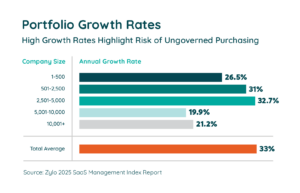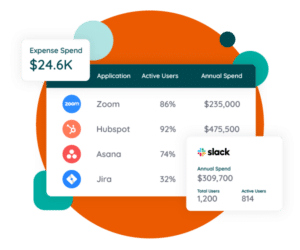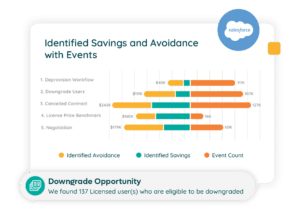Table of Contents
The use of SaaS in organizations has skyrocketed since 2015. No doubt, it will continue to do so. Utility and ease of access make SaaS applications one of the most attractive assets available to organizations of all sizes.
However, it comes at a cost, especially for large enterprises with 10,000 employees or more. These organizations are running an average of 660 applications in their portfolio. Each of which is operating under individual terms of service and license agreements. Thus, managing all of your organization’s SaaS applications has become a daunting challenge.
Furthermore, SaaS spending for today’s employers equates to approximately $4,830 per employee on SaaS. In total, these large enterprises are paying an average of $284M on SaaS every year.

Considering that cost, enterprises need to ensure that spending is driving the most possible value. Organizations must manage these assets effectively to improve ROI, and map created value back to the SaaS investments that made it possible.
That’s why we’re going to discuss the importance of application portfolio management.
What Is Application Portfolio Management?
Before we dig into the why and how, let’s answer the big question we all came here for. APM is a proactive approach an organization uses to manage its software application assets.
Sounds easy, sure – but the actual process itself is, of course, much more in-depth. Effective APM governs and optimizes an organization’s software assets – such as SaaS – to ensure the investments being made in this technology are driving meaningful impacts for the business. This means managing the digital inventory of applications to evaluate costs, create standards, and produce meaningful results.
Similar to the process of rationalizing your software applications, APM enables organizations to maintain utility while keeping costs and risks down.
More specifically, Application Portfolio Management enables an organization to:
- Create complete visibility of applications
- Optimize available licenses
- Rationalize the application portfolio
- Manage SaaS renewals
- And ensure compliance and governance across the business
Additionally, this system is continuous, accounting for all changes as the portfolio acquires and eliminates applications.
This process ensures an enterprise can align its applications to its business needs. This is essential in the world of SaaS which requires rigorous inventorying, and programmatic management to ensure employees get the tools they need. All the while, the portfolio is optimized for ROI and efficiency.
What Makes Application Portfolio Management Necessary
With the proliferation of SaaS, APM has become more important than ever to consider. It enables enterprises to overcome a variety of challenges that would otherwise grow in severity alongside the enterprise. Therefore, the programmatic approach of Application Portfolio Management is essential for scalability.
The foremost of these challenges that APM answers is the dynamic nature of a SaaS portfolio.
As we discussed, Zylo’s SaaS Management Index report found that large enterprises are using an average of 660 applications. The sheer number of these assets creates a problem in itself. Each of these applications has its own terms of service and contracts to account for. Should an enterprise fail to do this, not only does it risk being at odds with vendors, the enterprise risks data breaches and loss.
This is not even to mention the dilemma this creates for license renewals which require tracking to avoid unexpected costs or gaps in service.
To complicate the matter further, SaaS portfolios are constantly growing and changing. The average enterprise sees 12 new applications enter its environment every 30 days. Over the course of a year, these new apps contribute to 22% portfolio growth. Thus, large enterprises face a SaaS management challenge that often overwhelms manual processes.

These problems will only continue to grow by the day without proactive SaaS portfolio management. This is why visibility is key when managing applications. However, maintaining that visibility is once again a challenge for large enterprises. This is in part due to the size and changing nature of their application portfolios which we just discussed.

This worsened by the same factor that made SaaS so popular so to begin with: ease of access.
Accessibility has allowed employees throughout every level of business units to expense SaaS. This has provided employees the flexibility to work with tools that they are familiar with. However, it has also made it difficult to track every application in use without an established system of oversight.
It is for this reason that many applications fly under the radar as Shadow IT, and the trouble doesn’t end there.
Due to the proliferation of Shadow IT and the ease of access, the application portfolio of large enterprises can fluctuate over time.
Although larger enterprises experience lower adoption rates than smaller businesses at 45%, this still represents meaningful change. This creates a risk for applications to become lost in the shuffle. APM systems provide the oversight to prevent just that.
What Else Effective Application Portfolio Management Can Provide
APM of the fluctuating environment of SaaS portfolios does more than maintain control. It provides additional benefits that allow enterprises to do more with what they already have. Additionally, it frees them of a variety of risks and expenses.
Cost Savings
Every company is looking to cut costs where they can to protect their bottom line – even more so during uncertain economic times. This is why the cost-saving benefits of effective application portfolio management are very attractive.
In large enterprises, Zylo’s SaaS Management Index report found that the average enterprise spends $284M each year on SaaS alone. And in many organizations, SaaS spending is second only to headcount. Thus, it is only natural that an organization would want to ensure they’re getting the most value out of this spending.
 This comes at a time when the ease of access to SaaS acquisition means that business unit leaders to individual employees can expense SaaS without going through IT.
This comes at a time when the ease of access to SaaS acquisition means that business unit leaders to individual employees can expense SaaS without going through IT.
This decentralization of SaaS acquisition has resulted in sprawling costs. However, with proper application portfolio management, organizations can understand all applications in use across the organization and make strategic decisions about where and how to optimize – cutting costs, keeping them down, and maintaining, if not improving, their SaaS stack’s utility.
And better yet, when organizations free up spending from optimizing application assets, they can then reinvest that savings into other endeavors, be they software related or not.
This is achieved by establishing proper governance and oversight into the enterprise at all levels, enabling freedom within a framework for all business units.
Provide Employees with the Right Tools
On the note of freedom within limits, let’s touch on how a proper system of application portfolio management not only prevents Shadow IT through unauthorized acquisitions but maintains the flexibility employees have come to enjoy from SaaS applications.
Creating a system that establishes what SaaS options are available to employees with reasonable restrictions offers them the flexibility to use the tools they are familiar enables improved productivity across the enterprise.
Evolving Your SaaS Governance Framework for the Digital Workplace
Learn MoreAvoid Security and Compliance Risks
Data breaches are becoming more costly. In 2024, IBM reported the average cost in the United States alone was $4.88M. Therefore, it has been a major and justified concern for many companies.

Application portfolio management mitigates these risks by providing 100% visibility into your entire SaaS portfolio. Knowing what you have allows you to catalog and document all important security factors including what data is going into each application, who has access, and when was the last audit.
Furthermore, application portfolio management systems can track customer data stored or associated with time-sensitive licenses to prevent loss of data.
Make Application Portfolio Management Easy With a Comprehensive SaaS Management Platform
The bottom line here is that APM offers visibility, security, and effective maintenance of an enterprise’s SaaS portfolio. Furthermore, it doesn’t have to be difficult. With the proper tools, any enterprise can quickly establish its own system of management.
Zylo offers a comprehensive management platform that empowers your enterprise to manage its SaaS portfolio with total visibility and data-driven insights into your portfolio for better ROI without sacrificing utility. All the while, you create a system that enables you to take back control of your portfolio.
Schedule a demo with us today and see how we can help your organization manage your SaaS assets, and save without sacrificing utility.
ABOUT THE AUTHOR

Zylo
Zylo is the leading enterprise SaaS management platform that transforms how companies manage and optimize the vast and accelerating number of cloud-based applications organizations rely on today. The platform provides one system of record for all cloud-based software purchased across a company, enabling customers to discover, manage, measure and optimize cloud investments with real-time insights into spend, utilization and feedback data.

